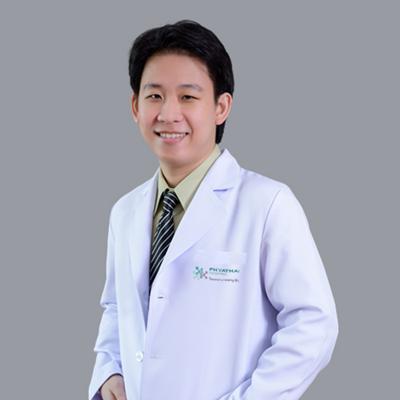
Dr. Chanwit Anukhrorwittaya
Dr. Chanwit Anukhrorwittaya
General info
Diseases of the nervous system and brain—if diagnosed accurately and treated properly—can be life-saving. This is the ultimate goal every doctor strives for.
Emphasis on accurate diagnosis
Dr. Chanwit Anukhrorwittaya, a neurologist specializing in stroke and neurosonology, focuses on enhancing the quality of life for both patients and their families after treatment. Currently, he cares for an average of 300–400 patients per month, with a strong emphasis on meticulous and comprehensive diagnosis to ensure effective and precise treatment—from the very beginning to the end result.
“For me, the nervous system and brain are vital and unique organs that allow humans to receive, process, and respond to information, as well as to store thoughts and memories. When abnormalities occur, physical examination and detailed history-taking become extremely important due to the complexity of the system. Neurological diseases include conditions such as ischemic stroke, hemorrhagic stroke, dementia, epilepsy, and movement disorders. If we can accurately differentiate and diagnose these conditions, it can greatly help the patient—reducing disability and economic loss.”
300–400 patients per month
The number of neurological patients under his care
Emphasizing detailed information
To promote understanding and correct patient behavior
Dr. Chanwit explains the condition to patients and their families clearly and thoroughly before beginning treatment—especially in cases involving dementia, where caregivers play a key role in medication management, diet, and physical therapy. He starts by explaining the root causes of the disease and continues with what tests are needed, how they are performed, how treatment works, and what treatment options are available—including the pros and cons of each.
Due to the complexity of neurological diseases, he uses various tools to aid in explanation. Sometimes he draws diagrams or uses models, charts, pictures, or videos to help patients visualize how different systems connect with the brain. As a result, most patients and families understand the condition better and can follow the treatment plan correctly.
Caring for patients like family
“I see my patients like my own relatives. I look for what’s best and most worthwhile for them. I avoid unnecessary treatments, but if something is beneficial and should be done, I present it as an option for us to decide together. I believe that when someone is ill and seeking treatment, many factors come into play—such as the doctor’s competence, the communication, whether the patient feels comfortable, and what technologies or methods are available. Personally, I aim to be clear and straightforward. If something is beyond my expertise or there’s a more skilled physician, I will make the appropriate referral and work collaboratively to build trust and confidence in the patient.”
Helping patients is his source of motivation and joy
“A doctor’s happiness comes from seeing patients recover. But what makes me proud is facing difficult cases and being determined to overcome them—examining every angle with care until we get the diagnosis right. When treatment is given promptly and patients recover, it’s incredibly fulfilling. There are also patients who keep coming back to see me just to talk and consult about their health—even though they’ve fully recovered—because they feel comfortable having me look after them. That, in itself, motivates me to keep improving and learning new things so I can help even more patients.”
Education
- 2005 Doctor of Medicine , Faculty of Medicine Siriraj Hospital, Mahidol University
Schedule
Neuro Medince
Neuro Medince
Neuro Medince
Neuro Medince